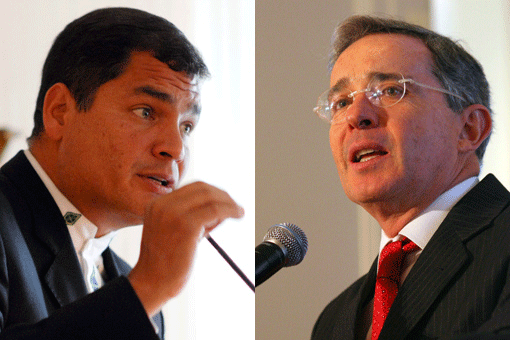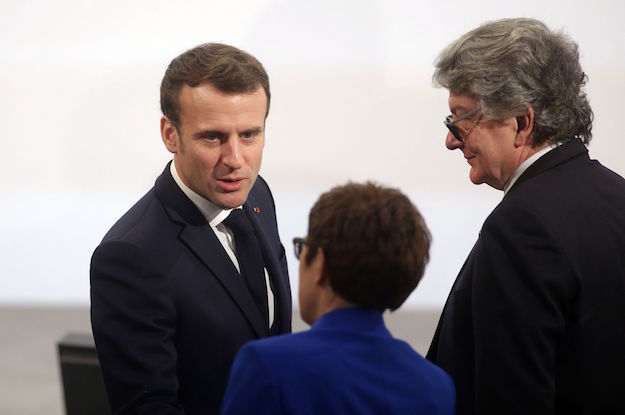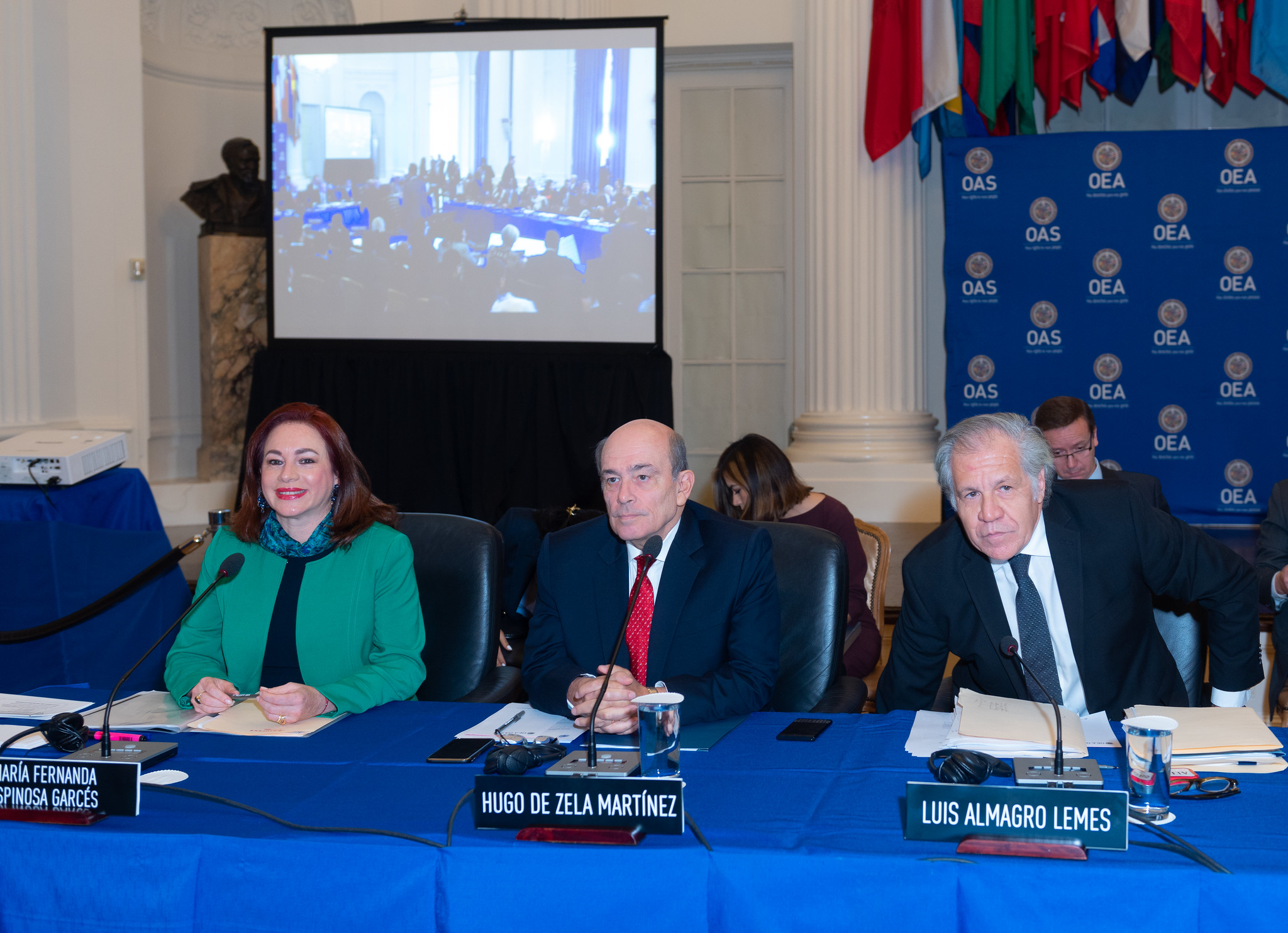A year after an Americas-wide effort to calm tensions between Quito and Bogotá moved into high gear, diplomatic relations remain ruptured. Despite efforts by the Group of Rio, the Organization of American States (OAS) and The Carter Center, the damage is unlikely to be repaired any time soon. This may be good for the illegal groups that operate on both sides of the 360-mile (580-kilometer) border. But it’s bleak news for those who hope for progress in advancing human rights, development and security in the Andean region.
The spark for this conflict was Colombia’s March 1, 2008 bombing of a Revolutionary Armed Forces of Colombia (FARC) camp inside Ecuadorian territory, killing high-level guerrilla leader Raúl Reyes and 24 others. Bilateral tensions had been simmering since 2000, in response to Colombia’s periodic campaigns of fumigation of drug crops near the border and incursions into Ecuadorian territory in pursuit of guerrillas. Colombian President Álvaro Uribe’s security policy pushed guerrillas toward the southern border with Ecuador. The result has been a spillover of illegal groups, illicit activities and refugees onto Ecuadorian territory.
Ironically, in the months before the March 1 bombing, relations between President Uribe and Ecuadorian President Rafael Correa had begun to improve. In January 2008, they established a high-level dialogue to address bilateral problems. But both presidents used the crisis to further bolster their already strong domestic support and to attract international attention to their conflicting opinions of the Colombian conflict. The Uribe government hailed the operation a success for it security policy and publicly warned Ecuador and other countries in the region that it would not tolerate support—tacit or active—of the FARC.
Ecuadorians remain deeply offended by what is popularly regarded as Colombian infringement of Ecuadorian sovereignty, and by Colombia’s efforts to link their country to the FARC. Over the past year, Correa and his ministers have turned relations with Colombia into a test of nationalism, a stance likely to help him during upcoming national elections. Sovereignty is a sensitive issue in Ecuador: since it gained its independence, Ecuador has lost 60 percent of its original territory through border wars with neighboring states. Correa’s ability to portray himself as a leader who can successfully stand up to larger countries (Colombia and, by extension, the U.S.) as well as to foreign interests such as multinational corporations, Wall Street and multilateral banks bolsters his electoral strength ahead of the April 26, 2009 elections, when the president and his movement, Alianza País, face their fifth electoral contest since 2006.
Meanwhile, the Uribe government’s aggressive public opinion campaign linking the Correa government to the FARC by alluding to information contained on the FARC computers has moderated. Foreign Minister Jaime Bermúdez has recently adopted a more conciliatory tone in his public statements, reiterating Colombia’s willingness to reestablish relations with Ecuador.
On January 23, 2009, the Ecuadorian Foreign Ministry released a communiqué outlining the conditions for reestablishing diplomatic relations. These conditions, which had been shared privately with the Uribe government through mediators over the last year, include: establishing military control on the Colombian side of the border; providing economic support to Colombian refugees through the UN High Commissioner for Refugees; releasing all details related to the carrying out of the attack; sharing the information related to Ecuador found in the FARC’s computers, and ending and retracting accusations that the Ecuadorian government has ties to the FARC. This last demand has been bolstered by OAS Secretary General José Miguel Insulza’s February 27 press comment during a visit to Ecuador that he saw no evidence of support by the Correa government to the FARC.
Colombia’s announcement on January 23 of its decision to increase troop deployment from 6,000 to 27,000 soldiers along the border is a positive step. However, Ecuador’s demands for details of the bombing and information in the computers could open a pandora’s box for Colombia and are unlikely to be met. Colombia is wary of releasing confidential information about its intelligence and military capabilities. As long as Ecuador remains married to the full list of demands, relations are unlikely to be reestablished.

Ecuador sees itself as a victim of the Colombia conflict and of the U.S.-supported Plan Colombia. As a poor country with little support from the international community, Ecuador resents that it is forced to devote scare resources to the spillover effects across its border, while much of its support to Colombian refugees goes unrecognized. This “negative agenda” has dominated bilateral relations, causing Ecuador to withdraw its Ambassador to Bogotá on more than one occasion, and has undermined the possibility for bilateral cooperation. Colombia maintains that Ecuador does not fully understand the significance of its struggle with FARC, and its potentially dangerous impact on the Andean region. What it wants more than anything else from Ecuador is broad security and intelligence cooperation, up to and including joint military operations.
That message may be getting through. Over the past year, Ecuadorians have signaled they are worried about the FARC presence on their territory. Correa has sought to distance himself from the information found on Raúl Reyes’ computers that some members of his government may have had ties to the FARC. He declared a “zero tolerance” policy toward the FARC, which meant isolating a close political collaborator as well as an Ecuadorian nongovernmental organization accused of FARC ties. He has also adopted a more aggressive military posture. Ecuadorian troops have destroyed 170 FARC installations in 2008, some 8,000 military and 3,000 police have been deployed in the border area, and Ecuador has improved its surveillance capacity. Last year, it purchased 24 Embraer-built Super Tulcanos aircraft for border control. Limited military cooperation with Colombia, ruptured along with diplomatic relations, exists under an agreement forged by the OAS last year.
Interestingly, commercial and trade relations have not suffered. Yet, at the same time, the longstanding bilateral problems over security and development needs along the border are not being effectively addressed. As things stand now, dispute mechanisms and a dozen joint development projects—in areas such as water and environmental management, infrastructure, health, human rights, and judicial cooperation—are on hold even though both countries agreed to them in 2006 as part of the Andean Community of Nations (CAN) Zone of Border Integration (“ZIF’) scheme.
This impasse reveals a failure of diplomacy by the international community, as well as by the two governments involved. It is questionable whether the two presidents have the political will to mend relations on their own. More active political support by OAS member states would help the OAS’s General Secretary’s efforts. The direct involvement of a powerful hemispheric leader would also help. One candidate might be Brazilian President Luiz Inácio Lula da Silva, who enjoys the confidence of both presidents.
The U.S. should also be more pro-active in addressing security and development needs along the Colombia-Ecuador border. With U.S. assistance already flowing to conflict zones on the Colombian side of the border, the U.S. should increase support to “Plan Ecuador”—the Correa government’s own development plan aimed at increasing state presence and delivering social services and development aid to the five under-served border departments. Also helpful would be U.S. assistance to some 150,000 Colombian refugees in Ecuador, and financing for some of the joint border development projects already identified by the governments of Ecuador and Colombia as part of the Zone of Border Integration.
The bottom line is that inaction would be the worst response of all. It would give a free hand to the guerrillas and criminal groups who have turned the borderlands into a center for the trafficking of drugs, precursor chemicals and people. A clear lesson for the region’s leaders is that the void left by under-development and an ineffective state will always be filled by those prepared to exploit it for nefarious purposes.






